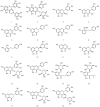Chemical Constituents and α-Glucosidase Inhibitory, Antioxidant and Hepatoprotective Activities of Ampelopsis grossedentata
- PMID: 38138447
- PMCID: PMC10745659
- DOI: 10.3390/molecules28247956
Chemical Constituents and α-Glucosidase Inhibitory, Antioxidant and Hepatoprotective Activities of Ampelopsis grossedentata
Abstract
Ampelopsis grossedentata is a valuable medicinal and edible plant, which is often used as a traditional tea by the Tujia people in China. A. grossedentata has numerous biological activities and is now widely used in the pharmaceutical and food industries. In this study, two new flavonoids (1-2) and seventeen known compounds (3-19) were isolated and identified from the dried stems and leaves of A. grossedentata. These isolated compounds were characterized by various spectroscopic data including mass spectrometry and nuclear magnetic resonance spectroscopy. All isolates were assessed for their α-glucosidase inhibitory, antioxidant, and hepatoprotective activities, and their structure-activity relationships were further discussed. The results indicated that compound 1 exhibited effective inhibitory activity against α-glucosidase, with an IC50 value of 0.21 μM. In addition, compounds 1-2 demonstrated not only potent antioxidant activities but also superior hepatoprotective properties. The findings of this study could serve as a reference for the development of A. grossedentata-derived products or drugs aimed at realizing their antidiabetic, antioxidant, and hepatoprotective functions.
Keywords: Ampelopsis; Ampelopsis grossedentata; antioxidant; flavonoids; hepatoprotective activity; α-glucosidase inhibitory.
Conflict of interest statement
Author Xu-Dong Zhou has received research grants from Hunan Qiankun Biotechnology Co., Ltd. Author Xu-Dong Zhou has been involved as an expert witness in Hunan Qiankun Biotechnology Co., Ltd.
Figures



References
-
- Zhang Y., Li J., Huang D., Ouyang W., Yao R., He S., Li S. Research Progress on chemical constituents and anti-infective effects of the traditional Chinese medicine vine tea (Ampelopsis grossedentata) Mod. Tradit. Chin. Med. Mater. Medica World Sci. Technol. 2021;23:2012–2022.
-
- Carneiro R.C., Ye L., Baek N., Teixeira G.H., O’Keefe S.F. Vine tea (Ampelopsis grossedentata): A review of chemical composition, functional properties, and potential food applications. J. Funct. Foods. 2021;76:104317. doi: 10.1016/j.jff.2020.104317. - DOI
-
- Jia C., Li J., Zhang M., Ma W., Zhao S., Liu R., Rong J., Li X. Antioxidant properties of the extracts of vine tea (Ampelopsis grossedentata) with the different color characteristics and inhibition of rapeseed and sunflower oil oxidation. LWT. 2021;136:110292. doi: 10.1016/j.lwt.2020.110292. - DOI
MeSH terms
Substances
Grants and funding
- 20C1397/Scientific research project of Hunan Provincial Department of Education
- 2021/Special Scientific and Technological Project for Comprehensive Utilization of Ampelopsis grossedentata Resources of Hunan Qiankun Biotechnology Co., Ltd.
- 2022A2-19/discipline construction program of Hunan University of Chinese Medicine
- 2021YX11, 202286 & 2023CX71/Innovation Training program for students in Hunan University of Chinese Medicine
LinkOut - more resources
Full Text Sources
Other Literature Sources
Medical

